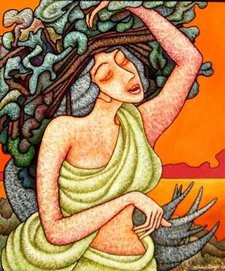One of boys who works for my husband was getting married and invited us to the wedding reception. I was quite excited. I would get to see an Egyptian wedding!
An Egyptian wedding held great attraction for me, not just from a curiosity perspective but also from a desire to see how similar it was to Indian weddings. I keep saying that Egyptians are emotionally very similar to Indians, so wanted to see whether the similarility extended to wedding as well cos weddings, after all, are very emotional affairs!
In India, weddings are a gala affair with festivities stretching many days. There is a lot of singing and dancing and its also an occassion for families to come together and re-aquaint themselves with hitherto forgetten realtives.
The wedding reception was in the posh neighbourhood of Heliopolis at a place which my driver assured me was very "exespensive" . We stepped into the wedding hall and were hit in the solar plexus by some really really loud music.
There was a big stage on one side of a huge hall, a better part of which was occupied by heavy duty sound systems and musicians playing all sorts of music instruments. There was a professional singer who was belting out what appeared to be traditional wedding songs as there was a lot of laughther and clapping accompanying his words. The bride and bridegroom were in the centre of the crowd, dancing and clearly enjoying themselves.
On enquiring, I was told that the actual wedding consists of signing of a contract between the bride and the bridegroom which spells out the terms of their mariage and their responsibilities. This is signed in the presence of a cleric and is called a " ". Subsequent to that, the wedding is celebrated by a reception (dependent on the economic situation of the wedding couple)
Certain aspects of Egyptian weddings in urban cities are like weddings anywhere else in the the world. The influence of Christiany of the nature of the celebrations is very obvious.
The bride wears a bridal dress and the groom wears a black suit or a tuxedo. The ceremony starts with a car parade. The wedding car (as prestigious as possible) is decorated with flowers and ribbons. Cars of both families move together in a noisy parade of continuous sounding of car horns to a wedding hall, most often in a hotel. The honking is to announce that there is a wedding taking place.
When the bride and groom reach the hotel they are received by a “Zaffa”. The Zaffa is another human parade of belly dancers and drummers surrounding the bride and groom, singing happy songs. The bride and groom will occasionally join in the dancing but the main aim is to walk as slowly as possible to the wedding hall. Some Zaffa’s will last an hour!
When the bride and groom finally reach the their destination in the hall they sit in the “Kosha”. The Kosha usually consists of two comfortable seats in front of the guests where the bride and groom reign as though king and queen. As soon as the bride and groom are seated in the Kosha a rose sherbet drink is passed to the guests and all drink to their health.
Then the bride and groom will switch rings from right index fingers to left index finger. This is probably an old Christian tradition but it is done whether the couple is Moslem or Christian.
With this ritual, the festivities begin. The bride and groom have the first dance after which the other wedding guests join in.
Unfortunately, we missed all of this, cos we were at an reception, celebrating an Indian festival. We caught the festivities, a little after they had begun.
I was amazed at the variety of entertainment. There were belly dancers, some African dancers, stilt walkers dancing and jumping around, tanoura dancers etc. The singer handed the mike to the bride who sang a wedding song where she expresses her love for her new bridegroom. I thought that was really cute! This was followed by the groom doing a tribal dance with one of the African dancers, spear in hand. Everyone sang a song with the groom playing the tambourine and the girl dancing to his tune..
Then the African dancers created two human trains - one male, led by the groom, and another female, led by the bride. They circled all around the reception hall, inviting everyone to join the train and the wedding couple's happiness.
The one thing that struck me that everyone around was having great fun. The women were dressed to kill with fabulous head scarves in myriad colours, shapes and styles. Clearly, a lot of time and effort was spent in deciding what to wear at the reception (sound familiar eh?)
The bride and bridegroom then went and sat at the Kosha and people queued up to wish them and get their photographs taken. After this, the buffet was opened.
Before I knew, it was close to 2 o'clock at night and it was time to go home. Well, it was time for us to go home, the Egyptians were going to be partying till 4 or 5 in the morning. The one thing that struk me was that everyone, including the bride and the bridegroom were having great fun, it would be a day that the wedding couple would really remember for the rest of their lives!
I was so glad that I came and was a part of these festivities. One of the advantages of being a mobile expat is that you get to witness so may different cultures, and experinences and have the privelege of imbibing some of them. So we have decided that while our son will have a traditional Indian wedding, we must make sure that the wedding reception is Egyptian style!!
Saturday, November 17, 2007
Subscribe to:
Comments (Atom)


